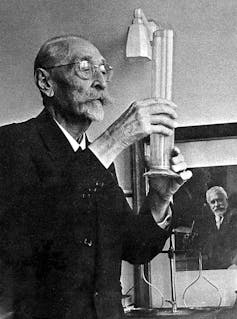In March 2020, as the UK was preparing to go into lockdown, two new trials were posted on the clinicaltrials.gov database. The researchers were proposing that BCG, an old vaccine against tuberculosis (TB), should be tested for its protective effect against COVID.
As vaccines tend to activate very specific immune responses against their target disease, why did these scientists believe that BCG might have an effect against this profoundly different pathogen?
In fact, almost since its first use against TB just over 100 years ago, BCG has been known to have “non-specific protective effects”. In other words, it can prevent diseases other than TB.
BCG was developed in France by two doctors, Albert Calmette and Camille Guérin – hence its name: Bacillus Calmette-Guérin. Between 1908 and 1921 Calmette and Guérin repeatedly cultured (on slices of potato) the organism responsible for TB in cattle until it no longer caused disease in animals. It also protected these same animals when they were later challenged with the human version: Mycobacterium tuberculosis.

Unknown author/Wikimedia, CC BY
Within a few years, BCG was being injected into children, delivering high levels of protection against TB with few side-effects. In 1931, Calmette suggested that BCG also prevented death from infectious diseases other than TB, an observation partly supported by data from studies in Sweden.
A recent reanalysis of the Swedish data concluded that although there was an element of “healthy vaccinee bias” in some of the data (that is, people in better health are more likely to get vaccinated), the results did support a non-specific protective effect of BCG. Later observations and trials also reported non-specific protective effects of BCG against lung infections unrelated to TB.
The key to BCG’s ability to induce a general state of readiness in the immune system, a phenomenon known as “trained immunity”, is tied to its identity as a live microorganism with a complex outer cell wall. Certain components of this cell wall are detected by the oldest (in evolutionary terms) elements of the immune system, also called the innate response. This interaction programmes innate immune cells to respond more effectively to any microorganism they encounter.
Vaccine against cancer
The beneficial effects of BCG are not restricted to infectious disease. The administration of live or dead bacteria as a treatment for cancer was pioneered in the 19th century. The effects against cancer of mycobacteria in particular were noted in the early 20th century, leading to the establishment of BCG delivered directly to the bladder as a treatment against non-muscle invasive bladder cancer – where the cancer cells are only in the inner lining of the bladder. It is still the standard treatment for this type of cancer.
Trials of BCG immunotherapy for other types of cancer have delivered mixed results. Some studies reported a lack of any effect against general malignancies. Others suggested an effect against childhood leukaemia or even a dramatic long-term effect against lung cancer. Direct injection into melanoma lesions has revealed positive results, whereas administration of BCG by the standard injection into the upper arm is less convincing at treating melanoma.
To effectively destroy cancer cells, the immune system deploys many of the same weapons that are also effective against viruses and bacteria that like to live inside our cells. What is more, the trained immunity effect bestowed by BCG either directly or indirectly activates these same weapons. In other words, BCG is “immunostimulatory”.
It may come as a surprise therefore, to discover that some of the non-specific protective effects of BCG work against diseases where the immune system is overactive, or misfiring against the wrong targets. For example, the autoimmune conditions multiple sclerosis and type 1 diabetes. In these cases, BCG is having an opposite and beneficial, immune-dampening, effect.
Studies have shown that BCG can reduce and prevent immune-mediated damage to the nervous system in multiple sclerosis. It can also counteract rogue immune cells that attack insulin production in the pancreas of diabetic patients. In both multiple sclerosis and type 1 diabetes, BCG’s ability to reprogram metabolism in cells as well as its capacity to increase numbers of special immune-dampening T-cells are thought to play key roles.
…and against COVID
And what of BCG vaccination against COVID? Again, the picture is mixed. A recent meta-analysis – where data from several studies are combined and analysed – failed to find an overall protective effect. However, individual trials have reported some success. For example, a reduced risk of COVID six months after vaccination. Or, more dramatically, a 92% efficacy in adults with long-standing type 1 diabetes who were given BCG for the prevention of COVID.
BCG’s tendency to provide variable protection has been known for some time. This is true for its “day job” as a vaccine against TB, as well as for its non-specific protective effects. Several reasons have been proposed for this variability. Previous exposure to other microorganisms, such as bacteria from the same family as BCG, or parasitic worms may lead to the immune system making the wrong sort of response to BCG. Differences in the genetic background of recipients can also lead to less effective immune responses to BCG.
A better understanding of the environment in which BCG works most consistently to deliver its specific and non-specific effects will surely enable the effective use of this most versatile of vaccines in future.
![]()
Steven Smith does not work for, consult, own shares in or receive funding from any company or organisation that would benefit from this article, and has disclosed no relevant affiliations beyond their academic appointment.











